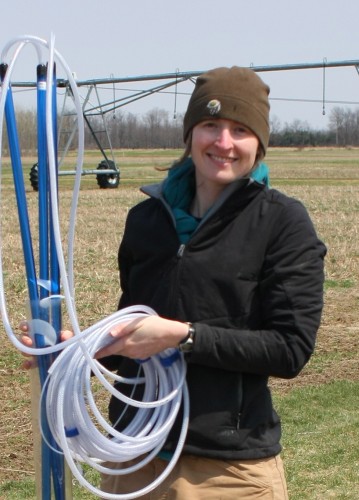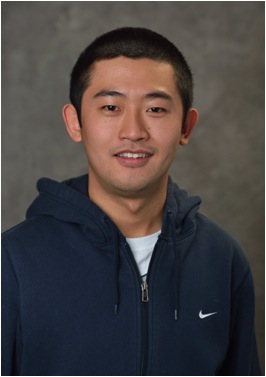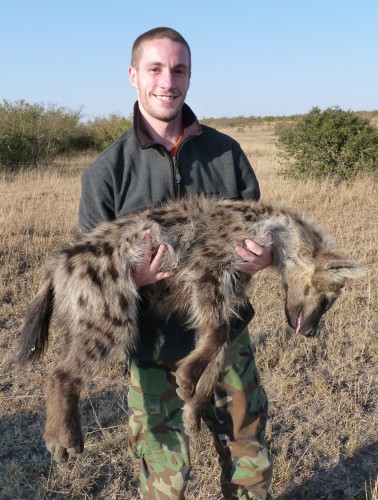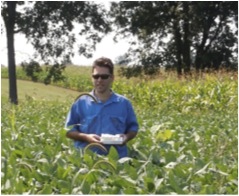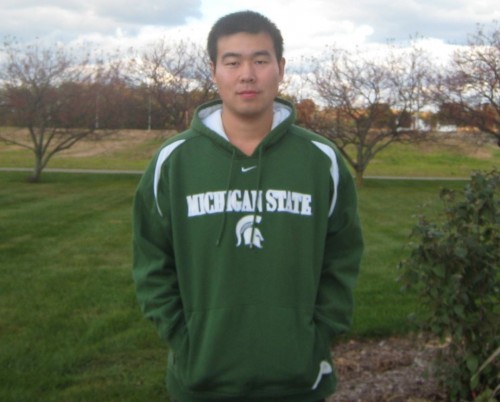Project Participants
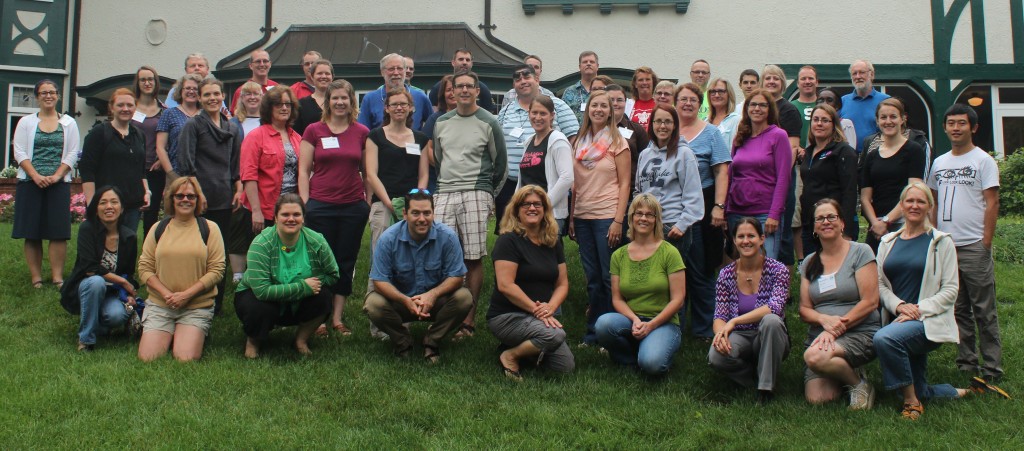
K-12 Teachers, GK-12 Fellows, Faculty, and Staff of the K-12 Partnership at the 2014 Summer Institute
The KBS K-12 Partnership consists of K-12 educators and administrators of 16 rural school districts plus graduate student fellows, research associates, and faculty from KBS and MSU departments of Zoology, Plant Biology, Crop and Soil Sciences, and Teacher Education.
2014-2015 KBS GK-12 Graduate Fellows
Partner District: Plainwell
Fellow Since 2014
Research Interests: Do you ever stay up at night wondering how agricultural liming contributes to the flux of carbon to our atmosphere and rivers? My research traces the fate of inorganic carbon as it is applied to agricultural soils as either crushed lime (calcium carbonate) to buffer soil pH or as bicarbonate dissolved in groundwater irrigation. In the soil these carbonates can act as either a source of CO2 to the atmosphere or a sink for keeping CO2 out of the atmosphere, but the relationship between nitrogen fertilizer amount, irrigation, and carbonate fate is not well understood. I hope to learn something about it through my research at the KBS LTER. I’m also interested in how groundwater irrigation is touted as an adaptation tool for farmers, however the sustainability of groundwater resources in the face of climate change is not well understood, especially for those aquifers that rely on annual recharge. I will be doing interviews of agricultural irrigators in southwest Michigan to explore their perceptions of groundwater and how they make decisions about using it. I am excited that the GK-12 program gives me the opportunity to bring my enthusiasm for ecology and science to a high school biology classroom, and I hope the experience will help me become a better teacher and communicator of science to diverse audiences. Go Plainwell Trojans!
Partner District: Plainwell
Fellow Since 2014
Research Interests: Broadly speaking, I am interested in exploring mitigation practices of greenhouse gas emission. My current research focuses on differentiating the contribution of nitrification and denitrification on the production of nitrous oxide (N2O) from soils with different management practices (tillage vs. non-tillage, fertilized vs. unfertilized, etc). Because nitrification and denitrification process occur in soils under different conditions, e.g. oxygen level, water content, etc, the enzymes involved and thus the underlying mechanisms leading to the N2O emission are also different. My research is based on the fact that 15N is unevenly distributed between the two N atoms in N2O molecule during microbial enzymatic reactions. Enzymes of special interests to me are nitrite reductase and nitric oxide reductase, which can be encoded by both soil nitrifiers and denitrifiers.
Site preference (SP), known as the difference of the relative abundance of 15N in central (α) and terminal (β) N atom in N2O molecule, has been recognized as a reliable way of tracing the N2O production pathways. Previous research demonstrated that SP values are directly related to the structure and function of enzymes involved in nitrification and denitrification process. Thus, I am conducting a series of pure culture studies to determine the intra-molecular distribution of 15N associated with unique SP values and certain enzymes. As different enzymes are involved in nitrification and denitrification process separately, different 15N fractionation and SP values would be expected. This research will lay a solid foundation for future efforts of quantifying sources of N2O in larger scales.
Partner District: Lawton
Fellow since 2014
Research Interests: As a community ecologist, I am broadly interested in the biological processes that control how and why we see species where we do. I conduct research primarily in freshwater ecosystems studying natural ponds in the field and in the lab using replicated miniature experimental pond units called mesocosms. I have also worked with the process of biotic invasion and homogenization in terrestrial plants and with the Lyme disease system.
My current Ph.D. research centers on understanding the role of dispersal in shaping the dynamics of metacommunities (sets of linked biotic communities). Although understanding the causes and consequences of dispersal is necessary to understand how species distribute and sort across ecological gradients, it is difficult to quantify the simultaneous movement rates of multiple interacting species in many natural systems. My research has generated large sets of empirical data on hundreds of freshwater plankton and invertebrate species that can be used to refine how metacommunities are modeled to better understand (1) how dispersal alters community and metacommunity trajectory, (2) how species balance tradeoffs between dispersal and local community interactions such as competition, and (3) how the impact of dispersal varies across spatial and temporal scales.
Partner District: Thornapple-Kellogg
Fellow Since 2014
Research Interests: My current research focuses on male spotted hyenas and how their dispersal process (moving from the social group a hyena was born in to another social group in a different territory where he will hopefully find a mate) works. In spotted hyena society males are at the bottom of the pecking order (and smaller than females, too!), so they sometimes have a rough time moving from one group to another. They can be aggressed upon by the females living in the new group and also by other males that moved to the new group first and don’t want other males moving there to compete for mating opportunities. Dispersing males also have to worry about getting killed by humans or lions along the way.
So what I want to know is what male spotted hyenas are looking for when it’s time to disperse. They’re highly mobile so they have lots of new territories to choose from, but what are their criteria when comparing all of their options? Males don’t always succeed when they try to join a new group either, so I also want to know what separates the males that succeed in settling in a new group from the males that fail to settle in that group.
In the classroom, I’m looking forward to 1) showing the students that spotted hyenas aren’t the villains they see in The Lion King, and 2) helping students engage in science in ways that leave them wanting more science courses in the future, not fewer.
Partner District: Parchment and Gull Lake
Fellow Since 2014
Research Interests: As a soil biologist I am interested in how nutrients cycle in natural and agricultural ecosystems. Less disturbed systems have soil biological processes which sustain them (fixing nitrogen and recycling nutrients). In many agricultural systems natural soil processes are altered their function reduced, leading in part to the need for large chemical inputs to agriculture. My research into these processes ranges from minute microbiological process to how Michigan farmers manage their soils from crop to crop. First, I study how increasing crop diversity helps agricultural soils enhance soil biological processes, reducing the need for inputs while maintaining services such as grain yield. Second, I examine two groups of bacteria which are critical to the soil nitrogen cycle. If these bacteria function inefficiently in soils they can lead to large losses of soil nitrogen out of the field instead of into the crop plant. Finally, I work directly with Michigan farmers to test their soils for indicators of healthy soil ecosystem properties and discuss with them how to manage their fields for improved soil quality.
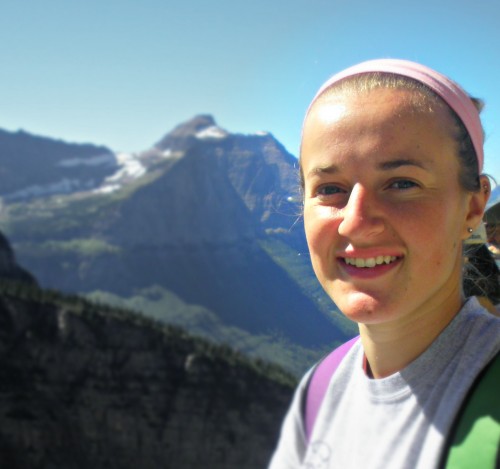 Name: Dani Fegan (fegandan@msu.edu)
Name: Dani Fegan (fegandan@msu.edu)
Partner District: Hastings
Degrees Held: B.A., Biology, Hope College
Fellow Since 2013
Research Interests: Broadly, I am interested in plant community, landscape, and restoration ecology. Increasingly, landscapes today are subject to degradation, fragmentation, and other human and natural changes that can affect the plant communities that reside within them. I am interested in how these changes affect processes within these communities. More specifically, I am interested in how heterogeneous landscapes affect movement of the community members within them. To explore these interests, I am studying seed dispersal in a large-scale restoration experiment in a longleaf pine community in South Carolina. Currently, I am evaluating whether or not restoration treatments, such as prescribed burning and overstory tree thinning, increase the overall density of seeds that disperse and/or have an effect on the distance that seeds can move, which can have implications for population and community movement.
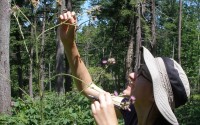 Name: Susan Magnoli (magnolis@msu.edu)
Name: Susan Magnoli (magnolis@msu.edu)
Partner District: Parchment & Lawton
Degrees Held: MS, Department of Biology, Sonoma State University, 2011; BS, Department of Plant Biology, UC Davis, 2008
Fellow Since 2013
Research Interests: My research is motivated by a fascination with invasive plants. As anyone who has ever pulled weeds knows, invaders can flourish in the habitats they invade. But how does a plant become so successful when introduced to a novel habitat? There are many possible reasons for why invaders are successful, but I’m interested in the role that evolution can play in invasion success. Particularly, my research focuses on how gene flow within an invasive species can facilitate adaptation to novel environments.
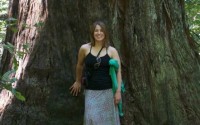 Name: Emily Dittmar (dittmare@msu.edu)
Name: Emily Dittmar (dittmare@msu.edu)
Partner District: Thornapple-Kellogg
Degrees Held: B.A., Biodiversity and Conservation Biology, Cedar Crest College, 2007
Fellow Since 2013
Research Interests: I am interested in understanding the genes that allow populations to adapt to their environments. It is still not understood whether adaptation is a result of changes in many genes, each individually having a small effect; or a few genes that individually have large effects. These patterns have implications for how quickly populations can adapt to new environments and how populations diverge as a result of habitat differences.
To address this question, I am studying an annual wildflower, Leptosiphon parviflorus, which is native to California. There are populations of this species that have adapted to serpentine soil, a soil type that is an extremely harsh environment for plants to grow on. I am comparing populations that grow on serpentine soil with populations that grow off of serpentine soil to determine the number of genetic differences between them. Ultimately, I hope to understand how many genetic changes it took to allow populations to live and reproduce on serpentine soil.
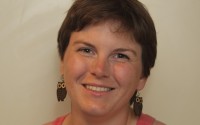 Name: Amanda Charbonneau (charbo24@msu.edu)
Name: Amanda Charbonneau (charbo24@msu.edu)
Partner District: Harper Creek & Olivet
Fellow Since 2013
Research Interests: I love nature and conservation issues, and I’m interested in evolution and how species adapt to new environments. For my graduate work, I’ve combined these interests to look at the genetics of ‘weediness’. For many agricultural weeds, we know the ancestor plant, but the ancestor didn’t act like a weed. In my system, weedy radish finishes it’s whole life cycle in only 40 days, while the ancestral radish takes nearly two years to start flowering. The obvious question is: what caused this big change in life cycle? We know that this shift has happened in the last 12,000 years or so since farming began, which in evolutionary time is pretty fast. Still, the changes must be genetic, because when I plant the ancestor in a farmer’s field, it doesn’t suddenly start acting like a weed. The long life cycle persists and in a farmers field it would be tilled under before it had a chance to flower. I’m looking at what genes have changed in the weedy radish to allow it to have a life cycle so much shorter than its ancestors. Does it only take one genetic change to make a weed? Two? Thousands?
Once we know what makes some radishes ‘weedy’ we can look in other agricultural weeds to see if they have similar changes from their ancestors. This can tell us a lot about how agricultural weeds work, and may suggest better control methods.
_______________________________________________________________________________
Former Fellows
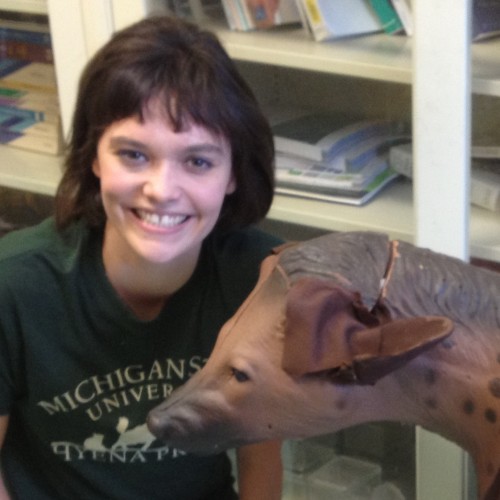 Name: Sarah Jones (joness94@msu.edu)
Name: Sarah Jones (joness94@msu.edu)
Partner District: Harper Creek
Degrees Held: B.Sc., Zoology, North Carolina State University, 2010
Fellow From 2013-2014
Research Interests: Every day we see people, from angry drivers to grumpy coworkers, engage in aggressive behavior. Though this is a part of everyday life, extreme or persistent forms of aggression can become a destructive force in our society. This has relevance to social issues ranging from bullying in schools to domestic violence. Both biological and environmental/cultural factors can predispose an individual to behaving aggressively. One of these factors is gender, with men committing the majority of violent crimes worldwide. Indeed, we see this pattern across mammals, with males engaging in more severe forms of aggression.
I study the biological causes of sex differences in aggression in spotted hyenas. Spotted hyenas are unusual mammals because females are more aggressive than males. I am trying to understand what hormonal and brain systems account for this role reversal. For example, do female hyenas experience increased exposure to “male” hormones (ie. testosterone) compared to other female mammals? Or do they have unusually low levels of serotonin, a brain chemical known to reduce aggression? Through this research, I hope to gain a better understanding of which body systems are most important in determining which sex is the more aggressive one. Understanding the biological roots of aggression can help us address behavioral problems in both humans and animals.
 Name: Cara Krieg (kriegca1@msu.edu)
Name: Cara Krieg (kriegca1@msu.edu)
Partner District: Plainwell & Co
Fellow From 2012-2014
Research Interests: I’m Cara Krieg and I’m a 3rd year graduate student at the Kellogg Biological Station. Growing up I was always interested in animals and now I study animal behavior. Have you ever heard someone say “men are from Mars and women are from Venus”? Have you ever wondered how much of this is a product of biology and how much is a result of culture? In nature males are typically the more aggressive sex, particularly when it comes to fighting over females. However, nature is complicated and females are often aggressive too. Why females fight and whether female aggression is different from males isn’t as well understood. Working with house wrens, I study aggression in males and females to understand how and why their fighting styles differ. House wrens compete aggressively for the valuable nest sites we provide to them. Using recorded songs and a model house wren, I simulate a threat to these nest sites and record the aggressive responses by the male and female birds. After measuring aggression, I keep track of the eggs and nestlings each bird raises to determine if aggression has consequences later down the road. Do the demands of raising offspring prevent one sex from being very aggressive? Does aggression provide a bigger benefit for the other sex? Or are the sexes more similar than we think?
 Name: Sara Garnett (garnett3@msu.edu)
Name: Sara Garnett (garnett3@msu.edu)
Partner District: Plainwell
Fellow From 2012-2014
Research Interests: Like most people with siblings, I am familiar with the potential for conflict in family relationships. Despite frequent competition with brothers and sisters for toys, parental attention, and access to the remote, you still love them and want them to succeed. This pattern is not unique to human families; seeking a balance between cooperation and competition happens in a wide variety of animals. We’re used to thinking about nature as a competitive place, where only intense fighting for shelter, food, and mates will bring success, but we see individuals put themselves at greater risk to predators or compete less intensely for food or mates when relatives are involved. Because relatives share at least some of the same genes, behaving in ways that help relatives survive and reproduce can be an effective strategy for an individual to pass its genes on to the next generation. This raises questions about when it is best for an individual to focus on itself vs. its relatives, as well as the strategies animals use to maintain this balance.
My research examines these questions using American toad tadpoles. They prefer to swim near siblings rather than non-siblings in their birth ponds, using chemicals in the water to tell them apart. I am investigating whether these chemicals might provide information that influence how quickly tadpoles grow and develop, or how intensely they compete for food. In particular, I am interested in whether they respond differently to siblings than non-relatives in different environments. By looking at how these factors influence tadpole growth, I can get an idea of how tadpoles improve the chance that they (and their siblings) will make it out of the pond in a variety of environmental conditions.
 Name: Jakob Nalley (nalleyja@msu.edu)
Name: Jakob Nalley (nalleyja@msu.edu)
Partner District: Olivet & KAMSC
Fellow From 2012-2014
Research Interests: My research into alternative fuel sources stems from a deep passion for understanding how we, as humans, can continue to develop as a society while maintaining our status as stewards of the Earth. As we continue to consume natural resources at extremely high rates, exterminate species, and pollute the environment around us, developing a more sustainable role for humans in the environment is extremely important. My research focuses on our energy consumption, mainly on indentifying an alternative fuel source to the traditional fossil fuel supplies humans have quickly diminished. I believe the answer is algae. A number of algal species contain a high amount of fats, the base component for diesel fuel production. Along with this high fat content, algae’s ability to quickly grow, consume carbon dioxide throughout its life cycle (decreasing the amount of CO2 in the atmosphere), and grow in uncultivated lands makes it an excellent alternative fuel source for our diesel fuel supply. I am focusing on how we can inexpensively grow algae in outdoor ponds all over the world. Specifically investigating whether in these ponds, a pond containing multiple species can continuously supply high amounts of fats for fuel generation while facing seasonal environmental changes (temperature, pH, light levels, etc.) and stave off invading algal species that may disrupt the community.
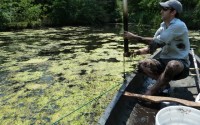 Name: Dustin Kincaid (kincai32@msu.edu)
Name: Dustin Kincaid (kincai32@msu.edu)
Partner District: Vicksburg & Gobles
Fellow From 2012 -2014
Research Interests: I study shallow freshwater ecosystems like streams, wetlands, and shallow lakes. I am broadly interested in environmental changes that influence surface water quality. One question I am investigating is how climate change, specifically the increased intensity of drought, alters the chemistry of surface water of streams, wetlands, and lakes that don’t typically experience dry periods. Another question I am interested in is how nutrient inputs from agriculture—primarily nitrogen (N) and phosphorous (P)—affect surface water quality. One current project I am working on is experimentally drying a wetland that hasn’t been dry for more than ten years in order to study the changes in surface water chemistry once the wetland is re-flooded.
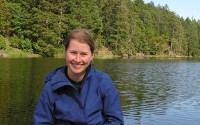 Name: Alycia Reynolds Lackey (reyno340@msu.edu)
Name: Alycia Reynolds Lackey (reyno340@msu.edu)
Partner District: Harper Creek
Degrees Held:
Fellow from 2010-2011, 2013
Research Interests: I am interested in how species interact with each other and with their environments. Broadly, I work on animal behavior, mating, competition, invasive species, resource use, habitat use, and impacts of habitat loss. More specifically, I study female mate choice and male-male competition in two species of stickleback fish, which are small minnow-sized fish living in freshwater lakes in British Columbia, Canada. My work explores how species’ interactions and environmental change can affect biodiversity.
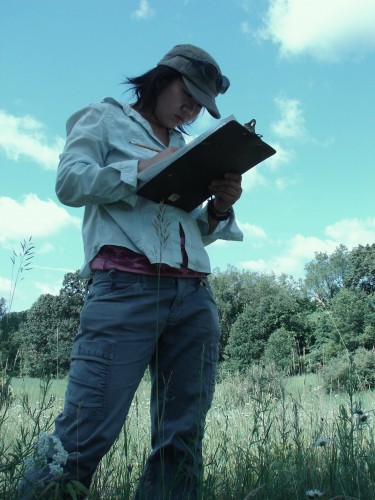 Name: Tomomi Suwa (suwatomo@msu.edu)
Name: Tomomi Suwa (suwatomo@msu.edu)
Partner District: KAMSC and Gull Lake
Degrees Held: M.S., School of Biological Sciences, University of Nebraska-Lincoln; B.Sc., Ecology, University of Guelph
Fellow from 2011 – 2013
Website: http://tomomisuwa.com
Research Interests: My research focuses on how soil bacteria make it possible for plants to live in different habitats. One of the soil bacteria, called rhizobia, live inside the roots of some plants and acts like natural fertilizer. Rhizobia can convert nitrogen in the atmosphere into ammonia, in a form that plants can use. In turn, plants can provide sugar to the rhizobia. This beneficial interaction is called a mutualism. Rhizobia can help plants grow in areas where they might not live otherwise. But just like human relationships, plants and rhizobia may not be compatible or one of the partners may not even be available! For example, rhizobia may not survive or convert nitrogen effectively in certain environmental conditions, like in shade or high areas of nitrogen in the soil. Using a native plant called the hog peanut (Amphicarpaea bracteata), I am looking at how rhizobia can make it possible for plants to live in different habitats.
Hog peanuts tend to grow in small patches in the forest and wetlands but it’s unclear why they grow in certain microhabitats. Is it because rhizobia are distributed in a patchy way or is it because rhizobia benefit plants differently in various environmental conditions? I am currently conducting a series of field and greenhouse experiments to test this hypothesis. So stay tuned!
 Name: Tyler Basset (basset17@msu.edu)
Name: Tyler Basset (basset17@msu.edu)
Partner District: Comstock and Parchment
Degrees Held:
Fellow from 2011 – 2013
Research Interests: Native ecosystems everywhere have seen lots of abuse as the human population increases and we demand more of the natural environment, and the upper Midwest is no exception. They are smaller, more fragmented, support less species than they used to, and many of those species are exotic (invaders from other continents). Ecosystems provide important “ecosystem services” – clean air, clean water, erosion and flood control, pollination, natural pest control – so scientists are trying to find out the best way to restore ecosystems. KBS graduate student and GK-12 fellow Tyler Bassett is exploring how many plant species are necessary to successfully restore native prairies that were a major part of southern Michigan’s landscape prior to European settlement. (In fact, the village of Richland sits at the center of where the 2,500 acre Gull Prairie once stood.) Ecosystems with greater diversity (more species) tend to be more resistant to invasion by exotic species and provide more ecosystem services consistently over time, but seed for restorations is expensive and adding more species may not necessarily lead to increased restoration success. You can see some of Tyler’s research on this issue at the Southwest Michigan Land Conservancy’s Woodlawn Preserve near KBS.
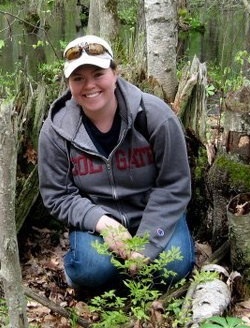 Name: Elizabeth Schultheis (schulth5@msu.edu)
Name: Elizabeth Schultheis (schulth5@msu.edu)
Partner District: Gobles
Degrees Held: BA, Environmental Biology, Colgate University, 2008
Fellow from 2010-2011, 2012-2013
Research Interests: My research is on invasive plant species and their interactions with the communities they invade. Specifically, I am interested in studying the role of plant soil feedbacks (PSF) in species invasions. I plant to look at factors such as time since invasion and relatedness to other individuals in the community to see if these factors affect the acquisition of soil enemies for a new invader. My current research uses Acer platanoides to study the Enemy Release Hypothesis and PSF to determine if A. platanoides’ ability to invade intact forests comes from a relatively more positive PSF as compared to the native A. saccharum, and whether these feedbacks can alter the outcome of competition.
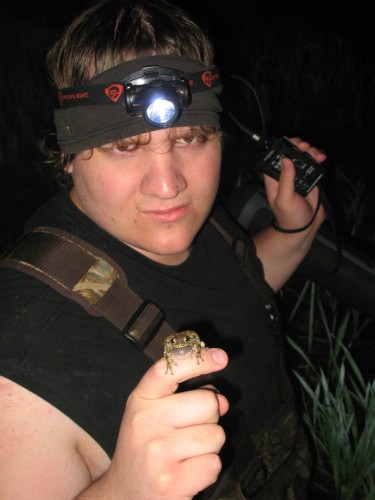 Name: Michael Kuczynski (kuczyns8@msu.edu)
Name: Michael Kuczynski (kuczyns8@msu.edu)
Partner District: Hastings and Delton-Kellogg
Degrees Held:
Fellow from 2011 – 2013
Research Interests: My name is Michael Kuczynski, I am a graduate student here at KBS studying the mating behaviors of local frogs and toads. If you have ever lived near a pond or swamp then chances are every spring your nights were filled with the sounds of singing frogs. Male frogs form these large choruses to attract females. We know that females prefer to mate with males that call at a high rate and produce long calls; however, not every male calls this way. Why wouldn’t every male try to call as frequently and as long as possible? Well one reason is that calling is costly; singing takes a lot of energy and exposes the frog to predators. Being eaten while trying to attract mates is obviously never a good thing, but it actually may be worse for some frogs than for others. A young male frog that gets eaten is losing out on several years worth of future mating opportunities. On the other hand, an old frog that gets eaten is not losing as much because he was near the end of his life anyways. In my research I investigate whether this difference in the cost of calling for old and young frogs influences their calling behavior. By making numerous recordings of frogs singing I can see whether older males are putting a greater effort into calling than younger males as a result of the younger males having more opportunities to mate in the future.
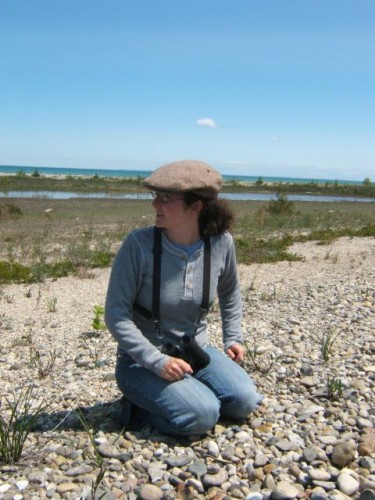 Name: Anne Royer (royerann@msu.edu)
Name: Anne Royer (royerann@msu.edu)
Partner District: Lawton
Degrees Held:
Fellow from 2012-2013
Research Interests: Growing up in rural Indiana, I spent summers running through fields, rolling around in the creek behind our house, and inspecting the plants and animals that surrounded me. This transformed into a professional interest – why do these organisms look the way they do? My research looks at how the shapes of flowers are influenced by natural selection from the insects that visit them.
Currently, my work focuses on the mustard plant family. Most flowers have many identical stamens (male structures), but mustards have two kinds within a flower – long and short ones. Long stamens seem to attract pollinators, but no one knows what the short stamens are for.
The data I have collected support the idea that the short stamens help the plant by slowing release of pollen (plant sperm) from flowers to insects. Like a secret chocolate stash – hard to find, so the pollen lasts longer and ends up spread more widely. However, for species that pollinate themselves without insects, short stamens may not be useful. So while most mustards make short stamens because they help them reproduce better, others seem to retain them just because their ancestors did – sort of an evolutionary bad habit.
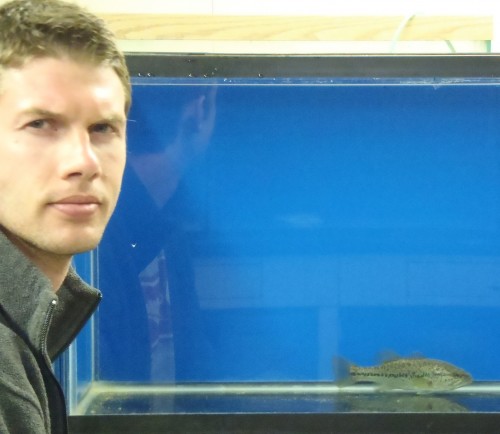 Name: Nicholas Ballew (ballewn1@msu.edu)
Name: Nicholas Ballew (ballewn1@msu.edu)
Partner District: Olivet
Degrees Held: B.A., Biological Sciences, Louisiana State University, 2006
Research Interests: Broadly, I am interested in how individuals in a population interact with each other and with their environments. I enjoy working on issues relating to the ecology and evolution of behavior, preferably in coupled human natural systems. Currently, I am investigating the relationship between personality and fitness in largemouth bass populations. I am comparing the fitness of personality types (such as bold vs. shy) in angled and non-angled populations to investigate if angling alters the relative fitness of personality phenotypes.
Name: Christine Neiman
Partner District: Vicksburg
Degrees Held:
Fellow from 2011-2012
Research Interests: My research at the Kellogg Biological Station concentrates on dairy nutrition at the pasture based robotic milking facility. When dairy cows are in a pasture based system they get most of their feed from the pasture. My work focuses on the effects of feeding not just the grass in the pasture but also providing a cut forage in the barn. I am looking to see if the feed provided in the barn will increase milk production. I am also interested in seeing if feeding some forage in the barn will decrease the amount of grass eaten in the pasture. Another very important factor in my research is the use of the automatic milking system by the cows. In the KBS dairy system the cows choose when they want to be milked by the robot. I am predicting that feeding the cows in the barn will increase the amount of visits to the robot. It was a very fun and interesting summer! I am currently working with all of my data and plan on bringing some of it to Vicksburg to help students learn more about data collection and analysis.
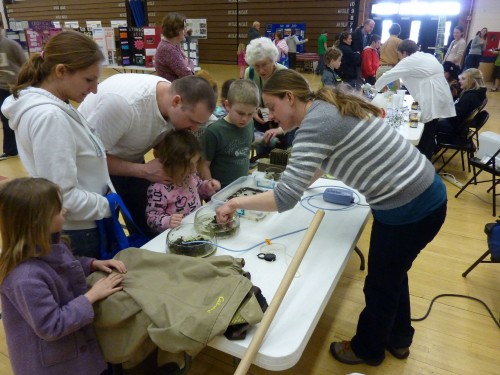 Name: Micaleila Desotelle (desotell@msu.edu)
Name: Micaleila Desotelle (desotell@msu.edu)
Partner District: Gobles
Degrees Held: M.A., Ecology and Evolutionary Biology, University of Kansas, 2007; B.S., Biology, Environmental Science, Winona State University, 2002
Research Interests: My research explores how food web subsidies can influence communities. I study the Kalamazoo River, which has several dams. Dams change the flow of the water and can increase the production of phytoplankton. The phytoplankton can act as a subsidy both temporally and spatially. Stream insect communities change along the river, and some of this response is to the subsidy from dams. Rivers frequently have multiple dams though many are aging and will be removed in the coming decades. Therefore, understanding how dams change food sources is important for the management of rivers.
 Name: Kate Steensma (steensm7@msu.edu)
Name: Kate Steensma (steensm7@msu.edu)
Partner District: Hastings
Degrees Held:
Fellow from 2011-2012
Research Interests: In agricultural systems, humans have some control over what an animal eats. It is important for farm animals to have a healthy diet, because they, in turn, produce food for us to eat. My research focuses on the behavior and foraging choices made by cows in a pasture dairy system. Even though their habitat is controlled by humans, cows in a pasture have the choice of which plant species they want to eat, and how much energy they want to expend in order to find their favorite plants. Cows also have the choice of when to visit the barn to get milked. The cows at Kellogg Biological Station, where I conduct my research, have a robot that milks them whenever they decide to visit. If a cow knows that a tasty pasture is waiting on the other side of the barn, she will spend the energy to get there by traveling through the barn, getting milked on the way. By understanding how cows make decisions about their food, we can offer different pasture choices that give them both a healthy diet and a motivation to visit the milker frequently, producing more delicious milk for us!
Partner District: Harper Creek
Degrees Held:
Fellow from 2011-2012
Research Interests: My research focuses on greenhouse gas (GHG) emissions from biofuel crop cultivation. A GHG is a gas in the atmosphere that absorbs infrared heat. This process keeps the earth warm because infrared heat otherwise would be radiated into space. However, more GHG in the atmosphere will absorb more heat and cause the earth warmer. Burning fossil fuels can release more CO2 into the atmosphere. Also, agricultural activities can emit the other two GHGs: CH4 and N2O besides CO2. Biofuels is one option to reduce GHG emissions and thereby slow global warming. However, GHGs can be produced from soil during growing biofuel crops such as switchgrass and prairie. CO2 is released when soil carbon is oxidized following tillage, methane oxidation is reduced when unmanaged lands are returned to cultivation, and nitrous oxide is released when soils are fertilized. This will decrease the value of biofuel for reducing CO2 emissions. My research is to look for appropriate agricultural practices such as fertilization and tillage to mitigate GHG emissions from growing biofuel crops.
Name: Kali Bird (birdkali@msu.edu)
Partner District: Plainwell
Degrees Held: B.S., Biology, Oklahoma Baptist University, 2008
Research Interests: Microbes may be the most abundant and diverse organisms on earth. They also mediate essential ecosystem processes, such as energy transfer to higher trophic levels and nutrient recycling. Broadly, I am interested in understanding feedbacks between the ecology of microbial communities and the environments in which they live. I am currently studying how availability of different phosphorus forms may impact microbial community structure, diversity, and ecosystem functioning through laboratory and field experiments. In the future, I hope to expand this research to include possible evolutionary feedbacks between the microbes and their environment.
Name: Iurii Shcherbak (shcherba@msu.edu)
Partner District: Plainwell
Degrees Held: Diploma in Computer Science, 2006, Moscow State University
Name: Nikhil Jaikumar (jaikumar@msu.edu)
Partner District: Comstock
Research Intersts: My research here at KBS focuses on the ecophysiology of perennial grain crops, more specifically perennial wheat, a newly developed hybrid of wheat and wheatgrass. The questions I am addressing are the following: 1) To what extent do various types of perennial wheat show tradeoffs between seed production and long-term persistence? To what extent and under what conditions can these tradeoffs be minimized, and how does perennial wheat manage these tradeoffs over its life history? 2) How resistant or resilient is perennial wheat to various types of stresses including low nitrogen levels, shading, drought or insect herbivory? Understanding more about the ecophysiology of this promising new species will increase our general understanding of tradeoffs between survival and reproduction in grasses and stress tolerance in perennial plants. It could also contribute a valuable new crop for marginal areas, which could yield important ecological as well as economic benefits.
Name: Lauren Kinsman (kinsmanl@msu.edu)
Partner District: Vicksburg
Research Interests: I study the ecology of shallow freshwater ecosystems like ponds, wetlands, and streams. I am particularly interested in biogeochemical cycling of nutrients in these ecosystems. For my dissertation research, I am investigating how fluctuating water levels influence phosphorus binding and release processes in sediments. I am currently testing the hypothesis that processes of phosphorus binding and release and controls over these processes depend heavily on characteristics of the sediment in an ecosystem (e.g., organic matter content, iron content).
Name: Melissa Kjelvik (kjelvikm@msu.edu)
Partner District: Delton-Kellogg
Degrees Held: B.S., Natural Resources, 2007
Research Interests: My current research concerns a tradeoff between foraging behaviors (bold or shy) and mortality in sunfish (Lepomis) populations and how multiple behaviors are maintained in populations. I will be testing whether sunfish learn these behaviors or if they are genetically predisposed to be bold or shy. I will also be examining how these behaviors affect population dynamics.

